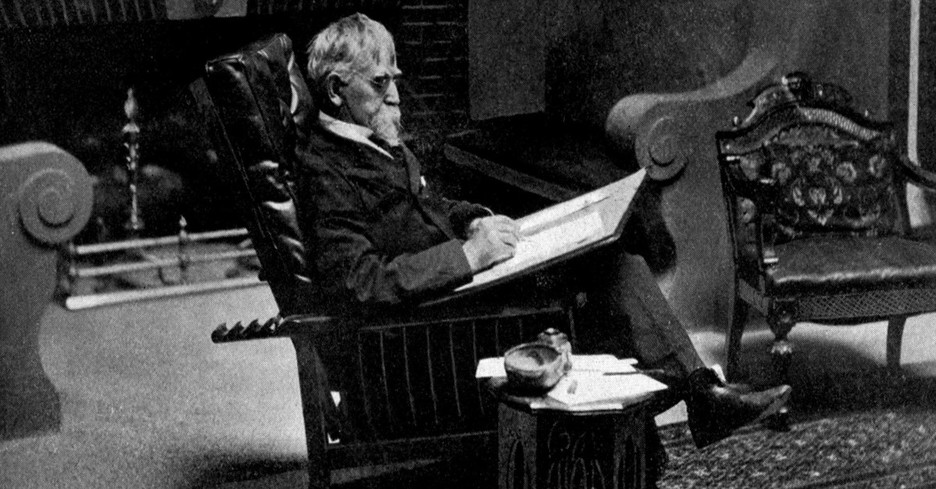
The year 2004 witnessed the incredible phenomenon of the film The Passion of the Christ thrusting the story of Jesus into the mainstream culture by means of an entertainment vehicle. Something similar happened 120 years ago through the novel Ben-Hur. Many Christians rejected all fiction on moral grounds, but exempted Ben-Hur because of the place Christ had in it and the light it shed on His day. It was also a gripping (though far-fetched) tale.
A Jewish youth, Ben-Hur finds his childhood friend, the Roman Messala, greatly changed after years in Rome. Messala has become superior and insolent. The two quarrel and part.
Depressed, Ben-Hur returns home and asks his mother if a Jew is not as good as a Roman. Her account of Jewish roots reaffirms him. He determines to learn war from the Romans.
The next day, Gratus, a new Roman governor, rides into Jerusalem. Leaning over the roof to observe, Ben-Hur dislodges a tile, which strikes Gratus. A riot ensues. Messala fingers Ben-Hur as the culprit, and he is torn from his family and sent to the galleys as a slave. His mother and sister are dragged off and he knows not where.
As Ben-Hur is marched toward his new existence as a slave behind an oar, the Romans pass through Nazareth, where he encounters Christ. Without saying a word, the boy Jesus gives Ben-Hur a life-saving drink.
The middle of the novel details Ben-Hur's release from the galleys, his rise in the world and his revenge on Messala, which is complete when he beats him in a chariot race that leaves Messala crippled. At the same time, Ben-Hur regains his family's wealth, which Messala had stolen. A Jewish agent had taunted Messala into staking his entire fortune on the race.
Meanwhile, Ben-Hur had met up with one of the wise men. The two argue over whether the Messiah will be a spiritual or political leader.
Ben-Hur returns to Jerusalem to search for his mother and sister, but they are nowhere to be found. He learns only that they were recently released from their cell, ravaged by leprosy.
Vowing revenge, Ben-Hur trains Galilean rebels to fight against Rome. He believes God has given him his wealth to help establish the Messiah on his throne. He follows Jesus with interest, but without understanding. When Jesus heals Ben-Hur's mother and sister, the three are reunited.
As Jesus is led to crucifixion, the grateful Ben-Hur offers to free him with his trained Galileans. Jesus is silent. The guards grab at Ben-Hur, who flees naked. He summons his Galileans only to find that they have melted away, siding with the Jewish leaders who want Christ put to death.
Overawed by the events of the crucifixion, Ben-Hur declares "...Truly as God lives, he who hangs yonder is the Son of God."
Thank You, Lew
Countless people wrote Lew, thanking him for his book. Many said they became Christians through it. One man wrote, "I could scarcely work, eat or sleep." Under deep conviction, he united with a church. "Since that time I have been blessed with a new home, a new life, and a perfect peace of mind." Ironically, Lew himself never joined a church.
30 Hours Straight
The former general and U. S. President Ulysses S. Grant informed Lew that he had become so enthralled with Ben-Hur he sat up 30 hours straight to read it from cover to cover.
In Trouble for Reading Ben-Hur
In the movie Anne of Green Gables, Anne got into trouble with her new teacher, Miss Stacy, for reading Ben-Hur when she should have been doing her class work.
Big, Big Book Order
For five years after its publication, Ben-Hur sales were sluggish. But as word of mouth traveled, sales rocketed and remained high. Even as late as 1913, when a Chicago mail-order company bought a million copies of Ben-Hur, it had no trouble distributing them all.
Train Ride with Razzle-Dazzle, or, How an Agnostic Inspired a Tale of the Christ
Ingersoll didn't mean to do it, but he goaded Lew into taking Christ seriously.
Taking a train to Indianapolis one evening, Lew Wallace heard someone call his name. It proved to be the notorious agnostic Robert Ingersoll, who, as a colonel with the 11th Illinois Cavalry volunteers, had fought under General Wallace at Shiloh. Ingersoll invited Lew into his compartment to talk.
Lew claimed the right to choose the subject. His themes were all of a religious nature. He gave them to Ingersoll and here is Lew's description of what happened.
He was in prime mood; and beginning, his ideas turned to speech, slowing like a heated river. His manner of putting things was marvelous; and as the Wedding Guest was held by the glittering eye of the Ancient Mariner, I sat spellbound, listening to a medley of argument, eloquence, wit, satire, audacity, irreverence, poetry, brilliant antitheses, and pungent excoriation of believers in God, Christ, and Heaven, the like of which I had never heard. He surpassed himself, and that is saying a great deal.
The speech was brought to an end by our arrival at the Indianapolis Central Station nearly two hours after its commencement. Upon alighting from the car, we separated, he to go to a hotel, and I to my brother's, a long way up northeast of town. The street-cars were at my service, but I preferred to walk, for I was in a confusion of mind not unlike dazement.
To explain this, it is necessary now to confess that my attitude with respect to religion had been one of absolute indifference. I had heard it argued times innumerable, always without interest. So, too, I had read the sermons of great preachers...but always for the surpassing charm of their rhetoric. But--how strange! To lift me out of my indifference, one would think only strong affirmations of things regarded holiest would do. Yet here was I now moved as never before, and by what? The most outright denials of all human knowledge of God, Christ, Heaven, and the Hereafter which figures so in the hope and faith of the believing everywhere. Was the Colonel right? What had I on which to answer yes or no? He had made me ashamed of my ignorance: and then--here is the unexpected of the affair--as I walked on in the cool darkness, I was aroused for the first time in my life to the importance of religion. To write all my reflections would require many pages. I pass them to say simply that I resolved to study the subject....
It only remains to say that I did as resolved, with results--first, the book Ben Hur, and second, a conviction amounting to absolute belief in God and the Divinity of Christ.
The Adventures of Author Lew Wallace
Christians should never despair of a problem child. Lew Wallace was one, and yet in the end, God was able to change his heart.
Born in Indiana in 1827, Lew simply had too much energy to be caged up. In and out of scrapes, he refused to so much as whimper when whipped. He seemed to know neither fear nor how to give in.
His mother died when he was 7, and he refused to accept his 19-year-old step-mom until she nursed him through croup he had caught while living in the wild.
When he was 9, he joined a brother at a boarding school several miles away. Hating it, he ran off and made his way home alone. At 13, he was truant from school for twelve days, attending a Whig rally. He became an instant hero with the Whigs when he climbed a roof and tore down a petticoat flying in mockery of Harrison, their Presidential candidate.
The only thing that tamed Lew for long was an interesting book. He devoured adventure novels and histories--and began writing his own stories. But unsatisfied with mere words, he ran away, hoping to join the fight in Texas. It was the last straw for his dad. Firmly but kindly, he ordered 15-year-old Lew out of the home.
Lew found work with a law firm. Although he detested law, he stood for elections as a public attorney, even fist-fighting if it helped him win. Once he pulled everyone away from a rival's speech by playing the violin.
He married his sweetheart Susan Elston. Her family didn't like him, but he won her father's respect when he leapt onto a burning roof to fight a fire.
Civil War Goat and Hero
During the Civil War, Lew fought for the Union. He was made the goat for the Union failure to capitalize on its costly victory at Shiloh. Shelved for a time, he brilliantly rallied the defense of Cincinnati, throwing up fortifications and building a pontoon bridge in record time.
His greatest fame as a general came when, outnumbered six to one, he held off the enemy at Monocacy long enough for the Union to move defenders to Washington, D.C. When people realized he had saved the capitol, he was smothered with praise. He wrote, "...a defeat did more for me than the victories I've engaged in."
After the war, he served on the war crimes trial. Later, he offered his services to Mexico, which accepted them but never reimbursed his costs. He was in debt most of his adult life, partly because of the Mexico affair and partly because Indiana's Free Soil party bilked him of money borrowed for them. In 1878, Lew accepted appointment as the governor of lawless New Mexico, where ruthless cattle barons and badmen made life miserable for everyone else. He restored order, then left to serve as U.S. ambassador to Turkey.
Measuring Christ or Measured by Christ?
Lew was drafting Ben Hur at the time. Up to that point, he had not even cared if there were an afterlife. But as he wrote, his outlook changed.
He came to recognize that Jesus must be taken for who He says He is. Ben-Hur had looked for a king to defeat Rome. Instead, he got a suffering Savior. Lew saw what this meant: "It is not an easy thing to shake off in a moment the expectations nurtured through years...He [Ben-Hur] persisted, as men do yet today in measuring the Christ by himself. How much better if we measured ourselves by the Christ?"
Resources:
1. Morsberger, Robert E. and Morsberger, Katherine M. Lew Wallace: Militant Romantic. McGraw Hill, 1980.
2. The Cambridge History of English and American Literature in 18 Volumes, 1907-21.
3. www.ben-hur.com/ben-hur.html
4. Wallace, Lew. The Illustrated Ben-Hur. Bonanza, 1978.
("Ben-Hur: General Lew Wallace and Some Little-Known Facts Behind His Famous 'Tale of the Christ.'" published on Christianity.com on June 11, 2010)
Photo Credit: public domain photo from 1901 How They Succeeded by Orison Swett Marden via Wikimedia Commons.



.jpg)